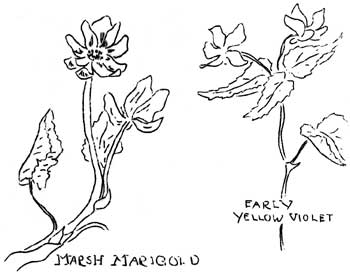
 | ||||||||
Look! It's summer! In just such sudden fashion does this favored season burst upon the high country. Late into June we find everything apparently gripped permanently in the firm clasp of winter's snowbanks. Then suddenly we notice a few bare spots upon the hillsides and presto!, before we realize it there, where once was snow, now we find great banks of flowers. Avalanche Lily we call them here for this well known Erythronium grows on the edge of the snowbanks in the sub-alpine meadows and actually blooms close by in great abundance. What a study in contrasts. But the Avalanche Lily - possibly you know it as Dog-toothed Violet,
Deer-tongue or similar names - is not the only early flower at this
elevation. This favorite flower is white and it has a cousin whose
petals are yellow that also aid in the glorification of these meadows
that are at this time shaking off the last vestige of winter. Abundant
moisture from the melting snow, an excellent soil and a warm mid-summer
sun prompts this quick transition from winter to summer.
White Rhododendron will be found in bloom on the lower edge of these sub-alpine meadows. This is a "Country cousin" of the state flower of Washington. In other words its beauty is shaded by the glowing glory of our state flower and is not as generally appreciated as it might be. But let us not forget the flowers of the wooded slopes. These, while not as abundant or showy, are just as interesting. And, in fact, the plant life in the forests is much more varied. One may find the slime molds, various fungi, mosses, ferns as well as the higher flowering plants here. Among the most conspicuous flowering plants at this time in the wooded areas are Star-flower (Trientalis latifolia), Woods or Forest Anemone (Anemone deltoidea) which is one of the most beautiful plants to be found here, the various huckleberries and violets, a dainty Collinsia known locally as Blue Eyed Mary because of its individual shade of blue, several closely related plants such as the Star-flowered Solomon's Seal (Vagnera stellata) and Fairy Bells (Disporum oregonum). The Canadian Dogwood or Bunch Berry (Cornus canadensis), Twinflower, Pipsissewa or Prince's Pine and many others are also found as one walks along these wooded trails. Two or three short, easy trails in various sections of the park which encompass the great variety of plant life found here are known as "nature trails" and one may readily learn the identity of the current flowers by reading the names which appear on small inconspicuous labels which stand before representative specimens on these trails. So great is the variety and number of these plants here at this season that to name them all would be impossible because of lack of space. Suffice to say that the height of the flower season is rapidly approaching and within a few weeks the glistening ice clad slopes of "The Mountain" and the verdant ranges that cluster at the base of the great volcano will be enlivened by the varied hues of many species at their best. 
From the low boundaries of the park to above timberline one finds a galaxy of multicolored blooms. Each life zone - each difference in elevation - supports its own plant life peculiar to that particular region. No wonder this area is a paradise for botanists and those generally interested in plants. | ||||||
| <<< Previous | > Cover < | Next >>> |
vol11-5b.htm
17-Nov-2001